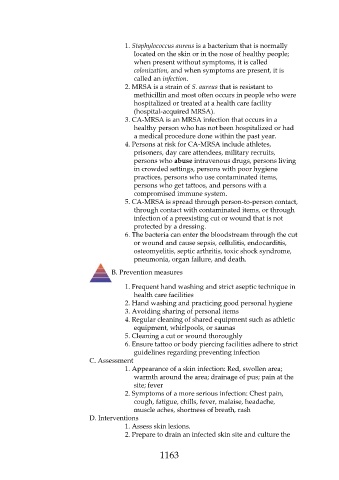Page 1163 - Saunders Comprehensive Review For NCLEX-RN
P. 1163
1. Staphylococcus aureus is a bacterium that is normally
located on the skin or in the nose of healthy people;
when present without symptoms, it is called
colonization, and when symptoms are present, it is
called an infection.
2. MRSA is a strain of S. aureus that is resistant to
methicillin and most often occurs in people who were
hospitalized or treated at a health care facility
(hospital-acquired MRSA).
3. CA-MRSA is an MRSA infection that occurs in a
healthy person who has not been hospitalized or had
a medical procedure done within the past year.
4. Persons at risk for CA-MRSA include athletes,
prisoners, day care attendees, military recruits,
persons who abuse intravenous drugs, persons living
in crowded settings, persons with poor hygiene
practices, persons who use contaminated items,
persons who get tattoos, and persons with a
compromised immune system.
5. CA-MRSA is spread through person-to-person contact,
through contact with contaminated items, or through
infection of a preexisting cut or wound that is not
protected by a dressing.
6. The bacteria can enter the bloodstream through the cut
or wound and cause sepsis, cellulitis, endocarditis,
osteomyelitis, septic arthritis, toxic shock syndrome,
pneumonia, organ failure, and death.
B. Prevention measures
1. Frequent hand washing and strict aseptic technique in
health care facilities
2. Hand washing and practicing good personal hygiene
3. Avoiding sharing of personal items
4. Regular cleaning of shared equipment such as athletic
equipment, whirlpools, or saunas
5. Cleaning a cut or wound thoroughly
6. Ensure tattoo or body piercing facilities adhere to strict
guidelines regarding preventing infection
C. Assessment
1. Appearance of a skin infection: Red, swollen area;
warmth around the area; drainage of pus; pain at the
site; fever
2. Symptoms of a more serious infection: Chest pain,
cough, fatigue, chills, fever, malaise, headache,
muscle aches, shortness of breath, rash
D. Interventions
1. Assess skin lesions.
2. Prepare to drain an infected skin site and culture the
1163

